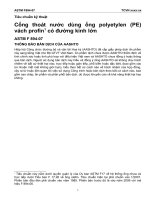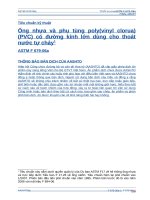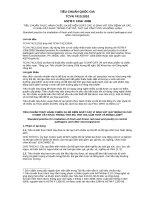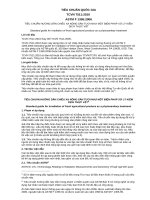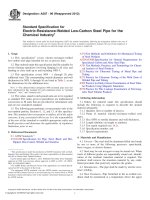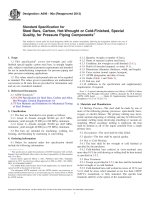Astm f 592 84 (2012)
Bạn đang xem bản rút gọn của tài liệu. Xem và tải ngay bản đầy đủ của tài liệu tại đây (173.99 KB, 5 trang )
Designation: F592 − 84 (Reapproved 2012)
Standard Terminology of
Collated and Cohered Fasteners and Their Application
Tools1
This standard is issued under the fixed designation F592; the number immediately following the designation indicates the year of original
adoption or, in the case of revision, the year of last revision. A number in parentheses indicates the year of last reapproval. A superscript
epsilon (´) indicates an editorial change since the last revision or reapproval.
INTRODUCTION
The terms included in these definitions are listed in alphabetical order to facilitate quick reference.
They are intended to apply to collated and cohered nails, staples, and pins driven by strike, pneumatic,
electric, manual, and spring tools. Omitted from consideration are terms relating to the testing and the
performance of fasteners, that is, their drivability, withdrawal resistance, pull-through resistance,
lateral load transmission, creep, protrusion resistance, splitting, and methods of use, such as face, toe,
side, and end-nailing, spacing, loading conditions, etc. Reference is made to ASTM Terminology
F547, Terminology of Nails for Use with Wood and Wood-Base Materials,2 for terms that are
applicable to related fasteners that may or may not be collated or cohered.
Common acceptance and usage are the basis for most of the definitions listed. In some instances,
this common usage results in more than one definition for a given term. In other cases, registered
trademarks have become generic in nature; hence, are included among the terms listed.
Any such listing cannot be complete. As additional terms are referred to the Society’s attention, they
will be considered for inclusion in this standard.
This listing of definitions of terms is in agreement so far as feasible with and supplementary to
Terminology F547.
The definitions are listed under the following headings:
Collated and Cohered Fasteners
Tools for Driving Collated and Cohered Fasteners
1
These definitions are under the jurisdiction of ASTM Committee F16 on
Fasteners and are the direct responsibility of Subcommittee F16.05 on Driven and
Other Fasteners.
Current edition approved April 1, 2012. Published May 2012. Originally
approved in 1978. Last previous edition approved in 2006 as F592 – 84 (2006).
DOI: 10.1520/F0592-84R12.
2
For referenced ASTM standards, visit the ASTM website, www.astm.org, or
contact ASTM Customer Service at For Annual Book of ASTM
Standards volume information, refer to the standard’s Document Summary page on
the ASTM website.
COLLATED AND COHERED FASTENERS
breakaway staple—staple with its crown designed to break off
if removal is attempted; used to discourage pilfering and
shop-lifting.
bevel point—point sheared obliquely to staple-leg axis, with
beveled face across staple-leg end; used to produce an
outward clinch or to provide additional penetration, or both,
in thin stapling member (see Fig. 1(A)).
by-pass clinch—clinch with legs paralleling and adjacent to
each other.
blind clinch—clinch between the layers of corrugated boards,
usually buried with wide-crown retractable anvil tools.
calendar staple—staple formed to provide a hanger for use
with calendars or booklets.
bookbinder’s wire—wire used in stitchers to fasten paper;
measured according to AWG sizes.
chisel point—point with two symmetrically beveled planes
forming “V” at end of staple leg, resulting in straight
penetration (see Fig. 1(B)). (See cross-cut chisel point.)
box stay wire—wire used in stitchers for assembly of containers; with dimensions measured in thousandths of inches.
Copyright © ASTM International, 100 Barr Harbor Drive, PO Box C700, West Conshohocken, PA 19428-2959. United States
1
F592 − 84 (2012)
NOTE 1—Staple chisel point has two faces, forming rectangular cross section; whereas nail chisel point (except collated T-nail chisel point and collated
round-head nail chisel point) has six faces, forming hexagonal cross section, that is, two major planes forming a “V” and pair of minor planes on each
flank (see ASTM Definitions F547).
FIG. 1 Various Types of Staple Points
cross-cut chisel point—chisel point with beveled point faces
parallel to staple-crown axis (see Fig. 1(C)). (See rightangle chisel point.)
clinch—protruding point end turned over or flattened when
driven or driven against clinching plate.
clinch point—point designed to facilitate clinching when
driven against clinching plate. (See step point.)
crown—staple end opposite staple point, connecting both
staple legs and providing bearing area.
clip—See strip.
clipped head—misnomer for D head. (See notched head.)
coated fastener—a fastener with appropriate material applied
to its surface to increase the fastener-withdrawal resistance.
crown width—overall width of staple including both staple
legs.
coiled—assembled in coil form.
D head—nail head with semi-circular rim and head segment
omitted during heading, with omitted segment reaching from
rim to shank projection, to allow tight collating of nails in
strip form.
collated—assembled in strip or other predetermined form.
divergent point—See divergent bevel point.
cohered—assembled in strip, coil, or other predetermined
form as defined in Terminology F547.
2
F592 − 84 (2012)
divergent bevel point—points sheared obliquely to staple-leg
axis, with beveled face in opposite direction on each leg,
across thick leg side leading from lower to upper thick face;
designed to lead staple legs into opposite directions perpendicular to staple plane during driving (see Fig. 1(D)).
lock stitch—a double stitch used at beginning and end of
manufacturer’s seam on corrugated boxes.
divergent chisel point—chisel point with beveled point faces
at angle to staple crown in plane perpendicular to staple
crown axis; designed to lead staple legs into opposite
directions perpendicular to staple plane during driving (see
Fig. 1(E)).
medium crown—staple crown usually larger than 5⁄16 in. (8
mm) and up to and including 11⁄16 in. (17 mm) in width.
manufacturer’s seam—joint produced by corrugated box
manufacturer during container fabrication.
narrow crown—staple crown usually 5⁄16 in. (8 mm) in width
or smaller.
notched head—nail head with semi-circular rim and “V”notch, having rounded “V” corners, wide notch part at rim,
and narrow notch part at nail-shank projection, formed
during heading, to allow tight collating of nails in strip form.
flat clinch—clinch formed by folding staple legs parallel to
crown with movable clincher.
flared—staple legs spread into outward opposite directions 90°
with crown plane.
outside bevel point—bevel point with its beveled face on
staple outside (see Fig. 1(G)).
flat crown—straight staple crown in contrast to rounded,
formed, or offset staple crown.
outside bevel divergent point—staple point with two-plane
beveled face on staple outside and along thick leg side;
designed to lead staple legs into opposite directions and to
result at the same time in their crossing during driving (see
Fig. 1(H)).
formed crown—staple crown formed during driving, for
example, for carding or fastening wire.
high crown—staple crown with inverted “V” wire crosssection prior to staple driving; designed to provide rigidity
during driving and flattened when fully driven. (see “V”
Crown.)
outward clinch—clinch with both staple legs flared outwardly
during driving.
hog ring, hog-ring staple—open-ended, rounded, ring, or
rectangular “U”-formed staple; used for encircling
applications, that is, for attaching materials to rounded or
rectangular base material by closing or wrapping hog ring
around base material.
partially preformed—not fully formed prior to driving.
preformed—formed prior to driving.
rack—longitudinal offset between adjacent fasteners within
strip of collated fasteners.
hybar wire—flat wire normally used in box stitching. Specifically:
Gage No.
000
00
0
1
2
3
racked fastener—fastener offset in strip.
ribbon wire—box stay wire of nominal 0.103 in. (2.62 mm) in
width.
Cross-Sectional Dimensions, in. (mm)
0.060 by 0.017 (1.52 by 0.43)
0.060 by 0.018 (1.52 by 0.46)
0.060 by 0.019 (1.52 by 0.48)
0.060 by 0.020 (1.52 by 0.51)
0.060 by 0.024 (1.52 by 0.61)
0.060 by 0.028 (1.52 by 0.71)
right-angle chisel point—chisel point with beveled point
faces parallel to staple-crown axis (see Fig. 1(I)). (See
cross-cut chisel point.)
rolled clinch—clinch formed by solid clincher against which
staple point is driven; obtained normally with desk stapler.
incomplete head—nail head with semi-circular rim and portion of head omitted during heading, to allow tight collating
of nails in strip form. (See D head, notched head.)
round or rounded crown—curved staple crown used in
wiring, carding, and encircling operations; also, in spring-up
applications in furniture manufacturing.
in-line clinch—flat clinch with both staple legs in straight
alignment.
saddle stapling—pamphlet or book stapling on a “V”-shaped
table, which permits placement of staple in center fold.
inside bevel point—bevel point with its beveled face on staple
inside; used to produce an outward clinch or to provide
additional penetration in the base material, or both (see Fig.
1(F)).
saddle stitching—Similar to saddle stapling; however, accomplished with wire stitcher.
leg—staple part connecting staple crown with staple point;
driven through and into or through materials being fastened.
spear point—symmetrical point with four bevel faces meeting
at point center (see Fig. 1(J)).
leg thickness—maximum dimension of staple-leg cross section measured parallel to staple-crown axis.
spring-clip staple—staple for fastening flat metal clip holding
undulated upholstery spring. Also, staple used to attach
coiled springs to frame in bedding manufacture where staple
serves as clip.
leg width—maximum dimension of staple-leg cross section
measured perpendicular to staple-crown axis.
3
F592 − 84 (2012)
automatic trip—machine-activated tool mechanism providing
continuous cycling while trip is in contact with the work.
spring crown—hip crown; designed to flatten during driving
in order to provide optimum lateral guidance in driving
channel of stapler. (See high crown; “V” crown.)
blade clincher—thin clinching arm; usually designed for
insertion between layers of corrugated boards.
square point—point sheared perpendicular to staple-leg axis
to form a pointless staple-leg end; known as blunt point (see
Fig. 1(K)).
bottom trip—tool activation by tool nose touching the work,
while at the same time activating trigger trip.
standard staple—staple with nominal 1⁄2 in. (13 mm)-wide
crown, 1⁄4 in. (6 mm)-long legs, made of 0.019 in. (0.48 mm)
wire, commonly used in desk-type staplers.
button clincher—circular clincher.
“C” blade—blade clincher resembling the letter “C”; designed
to fasten partially overlapping container panels.
staple—“U”-shaped wire fastener usually with two same-size
pointed or pointless legs connected by crown located opposite staple-point ends; designed to be driven by strike,
pneumatic, electric, manual or spring tools through or
through and into layers of penetrable material and to hold
two or more pieces together.
clincher—part of tool that folds fastener legs to form clinch.
clinching plate—(See anvil.) Also, hardened flat metal plate;
used in clinching nails and staples designed for clinching.
coil-fed tool—tool utilizing a coil of collated fasteners or a coil
or wire.
staple length—distance from top of staple crown to tip of
staple point (see Fig. 1(F)). Also referred to as leg length. In
contrast, length of bulk staple, driven by hand-hammer, is
measured from bottom of staple crown to tip of staple point.
contact trip—See bottom trip.
core—See rail.
door—combination nose and closure for nose-loading stapler.
staple point—See bevel point, chisel point, clinch point,
cross-cut chisel point, divergent point, inside bevel point,
outside bevel point, outside bevel divergent point, rightangle chisel point, spear point, step point.
staple spacing—dimension used to describe the relative location of staple or staples in workpiece; often, the dimension to
center or center-to-center of staple.
driver—tool component that pushes fastener from the driving
chamber of the tool into the members being assembled.
step point—notched point with step faces perpendicular to
staple crown; designed to facilitate self-clinching of staple
legs when driven against clinching plate (see Fig. 1(L)).
grooved guide body—formed guiding device used for placing
staple over work as in carding or wiring.
feeder shoe—See pusher.
follower—See pusher.
forked blade clincher—special clincher (anvil) for hooking
plastic bags to facilitate placement of encircling staple.
guide body—tool component that aligns and supports staple
during driving.
stick—See strip.
stitch—staple cut and formed from wire immediately prior to
driving by same machine.
lip—overhang of tool nose when magazine rests flush with
work surface.
strip—staples, nails, or pins collated and cohered to facilitate
automatic driving with appropriate tool.
long magazine—magazine providing space for more than
regular capacity of a particular tool style.
tie stitch—See lock stitch.
tube terminal staple—staple designed for use as a wiring
terminal in electronic assembly.
magazine—mechanism for storing and feeding fasteners.
mattress blade—special clinching blade for fastening sisal
pads in bedding plants, permitting stapling inside edging
wire.
undulated staple—staple with curves in crown for better
driving stability.
movable by-pass clincher—clinching mechanism for forming
a by-pass clinch.
“V”-crown—staple crown with inverted “V” cross section on
staple; used in spring-up work in furniture and bedding.
movable in-line clincher—clinching mechanism for forming
an in-line clinch.
wide crown—staple crown usually larger than 11⁄16 in. (17 mm)
in width.
nose—guide-body area where fastener is driven from tool.
TOOLS FOR DRIVING COLLATED AND COHERED
FASTENERS
anvil—tool arm against which staple legs are driven to form
clinch.
nose extension—See lip.
overhang—See lip.
plier—portable stapler with attached clincher for placing
staples away from edges of work.
arm—cantilever part of tool to hold the clinching mechanism,
permitting placement of fastener away from edges of the
work.
pointed blade—See pointed clincher.
pointed clincher—blade clincher with sharp point to facilitate
piercing of corrugated board.
4
F592 − 84 (2012)
post—post holding clincher to facilitate assembly of container
bottoms.
strike tacker—stapler activated by striking it with hand or
mallet.
pusher—tool mechanism for forcing fastener into driving
channel.
stitcher—machine that cuts, forms, and drives wire stitches.
stitching wire—See box stay wire.
strip-fed tool—tool using staples or nails that are collated and
cohered in strip form.
rail—magazine component required for alignment of fastener
and directing it into driving channel.
supporter—cam mechanism, especially spring-loaded; designed to provide crown and lateral guidance for staple in
driving channel of stapler.
remote fire tool—remotely controlled tool.
retractable anvil—curved clincher used in stapling from
outside of container.
sword-point anvil— See pointed clincher.
tacker—electric, manual, or pneumatic tool for driving lightwire staples without clinching.
safety mechanism—a device intended to prevent accidental
actuation of tool.
sealing blade—See blade clincher.
sidestrike—activation of stapling head resulting from forcing
container resting on table against head.
throat depth—distance at which a tool may place fastener
from edge of the work.
sisal plier—See plier; mattress blade.
slanted magazine—a magazine attached at an angle to tool;
used for storing clips of slanted nails or staples.
touch trip—See bottom trip.
track—See rail.
trigger trip—tool activation by trigger operation in conjunction with bottom trip activation.
tool—machine for driving fasteners.
solid clincher—non-moving clincher.
walking stick—long arm attached to tool allowing operator to
use it without bending over.
stick-fed tool—See strip-fed tool.
This standard is subject to revision at any time by the responsible technical committee and must be reviewed every five years and
if not revised, either reapproved or withdrawn. Your comments are invited either for revision of this standard or for additional standards
and should be addressed to ASTM International Headquarters. Your comments will receive careful consideration at a meeting of the
responsible technical committee, which you may attend. If you feel that your comments have not received a fair hearing you should
make your views known to the ASTM Committee on Standards, at the address shown below.
This standard is copyrighted by ASTM International, 100 Barr Harbor Drive, PO Box C700, West Conshohocken, PA 19428-2959,
United States. Individual reprints (single or multiple copies) of this standard may be obtained by contacting ASTM at the above
address or at 610-832-9585 (phone), 610-832-9555 (fax), or (e-mail); or through the ASTM website
(www.astm.org). Permission rights to photocopy the standard may also be secured from the ASTM website (www.astm.org/
COPYRIGHT/).
5
